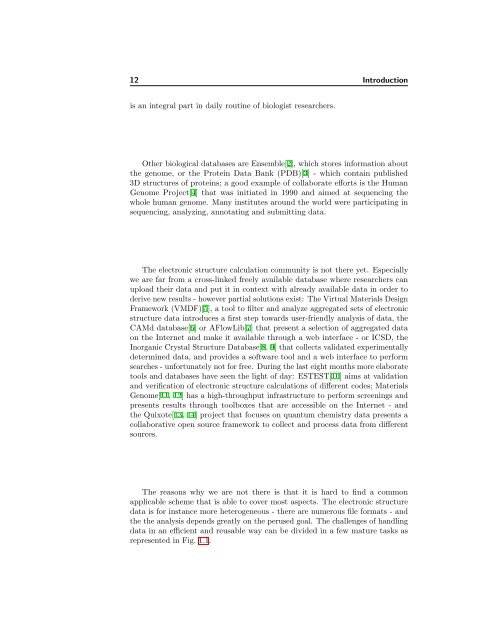The Computational Materials Repository
The Computational Materials Repository
The Computational Materials Repository
- No tags were found...
You also want an ePaper? Increase the reach of your titles
YUMPU automatically turns print PDFs into web optimized ePapers that Google loves.
12 Introductionis an integral part in daily routine of biologist researchers.Other biological databases are Ensemble[2], which stores information aboutthe genome, or the Protein Data Bank (PDB)[3] - which contain published3D structures of proteins; a good example of collaborate efforts is the HumanGenome Project[4] that was initiated in 1990 and aimed at sequencing thewhole human genome. Many institutes around the world were participating insequencing, analyzing, annotating and submitting data.<strong>The</strong> electronic structure calculation community is not there yet. Especiallywe are far from a cross-linked freely available database where researchers canupload their data and put it in context with already available data in order toderive new results - however partial solutions exist: <strong>The</strong> Virtual <strong>Materials</strong> DesignFramework (VMDF)[5], a tool to filter and analyze aggregated sets of electronicstructure data introduces a first step towards user-friendly analysis of data, theCAMd database[6] or AFlowLib[7] that present a selection of aggregated dataon the Internet and make it available through a web interface - or ICSD, theInorganic Crystal Structure Database[8, 9] that collects validated experimentallydetermined data, and provides a software tool and a web interface to performsearches - unfortunately not for free. During the last eight months more elaboratetools and databases have seen the light of day: ESTEST[10] aims at validationand verification of electronic structure calculations of different codes; <strong>Materials</strong>Genome[11, 12] has a high-throughput infrastructure to perform screenings andpresents results through toolboxes that are accessible on the Internet - andthe Quixote[13, 14] project that focuses on quantum chemistry data presents acollaborative open source framework to collect and process data from differentsources.<strong>The</strong> reasons why we are not there is that it is hard to find a commonapplicable scheme that is able to cover most aspects. <strong>The</strong> electronic structuredata is for instance more heterogeneous - there are numerous file formats - andthe the analysis depends greatly on the perused goal. <strong>The</strong> challenges of handlingdata in an efficient and reusable way can be divided in a few mature tasks asrepresented in Fig. 1.1.












